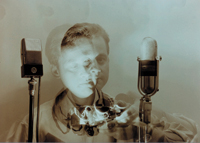
This is a FLAT
2-dimensional time-lapse picture,
come see 3D pictures at the exhibit!
EXPLORATIONS OF THE
THIRD DIMENSION
3-D stereoscopic images of the past and present
This exhibit illustrates some of the
important aspects of stereography,
3-D technologies, and
their place in history.
Stereography has been around since
the 1830's. Stereoscopic photography reached its peak of public
interest in the 1860's, with home parlors, railroad travel bureaus
and libraries developing vast collections of views. It was a way to
see the world before the time when travel was affordable or
convenient to the public. Throughout the remainder of the nineteenth
century, viewing stereoscopic images was a very popular pastime.
By the 1920's, the AM radio had
become the most valued centerpiece of the home parlor, and listening
to the airwaves drew attention away from stereoscopic viewing. At the
same time, passenger train travel reached its peak, and the advent of
the affordable automobile made travel easy and convenient. Much of
the world formerly seen only through stereoscopic images was now
within reach by train or automobile.
A new era in stereoscopic interest
began with the introduction of View-Master at the1939 New York
World's Fair, followed in the 1940's by a wave of camera
manufacturers offering easy to use camera-viewer-projector systems to
the consumer. They successfully sought the endorsement of celebrities
like John Wayne, Harold Lloyd, Edgar Bergen and President Dwight
Eisenhower. Advertising agencies, film studios, and manufacturers
often used stereography to promote their products.
Interest peaked again in the early
1950's when Hollywood introduced numerous 3D motion pictures, setting
off yet another wave of popularity with films like House of Wax, and
Alfred Hitchcock's Dial M for Murder.
Stereoscopic interest declined once
again in the 1960's as the television era moved into full swing. But
once again in the mid 1970's, a percentage of the baby boomers, whose
parents had stereo cameras in the 1940's to 60's, helped to
perpetuate the interest in stereo photography.
The 1990's advent of the affordable
personal computer and the internet provided yet another catalyst that
has brought much of the collective interest in stereo together
through digest forums websites, and the ability to deliver stereo
images via the computer screen. There are local stereo
clubs and societies, as well
as national and international stereoscopic societies.
Worldwide, thousands of
stereographers practice their craft professionally, or for personal
enjoyment. There are numerous publications on stereography, as well
as manufacturers
and distributors of current
and vintage stereographic cameras, accessories and related
items.
HOME
Gleason
Public Library
22 Bedford Road (Route 225)
Carlisle, MA 01741
978-369-4898
Library Hours: Mon., Tues.,
Thurs., 10 a.m. - 9 p.m.
Wed., 1:00 p.m. - 9 p.m.
Fri., Sat., 10 a.m. - 5 p.m.
